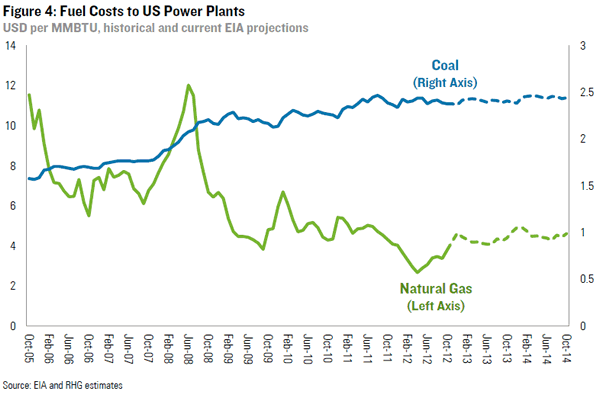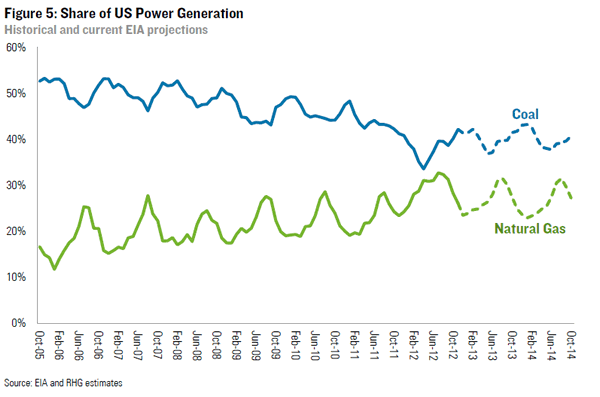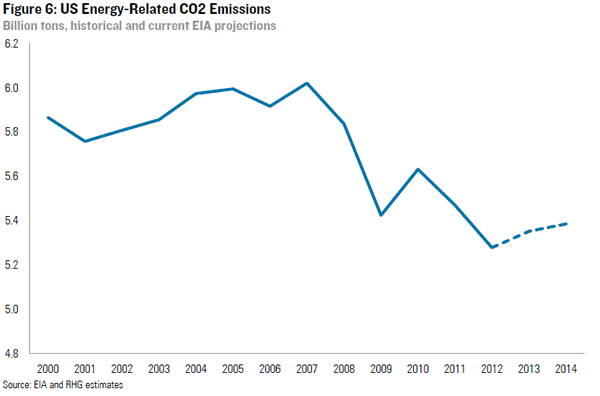Coal Claws Back
In his State of the Union address on Tuesday, President Obama welcomed the environmental benefits of low-cost natural gas, noting that US CO2 emissions have declined sharply over the past four years. Indeed, coal’s share of US electricity generation fell to 33% in April 2012, the lowest level seen in decades, thanks in large part to cheap natural gas, and US CO2 emissions in the first half of 2012 were 13% below 2005 levels. But as gas prices have risen in recent months, so has demand for coal for power generation. Absent new policy, the recent drop in emissions has likely run its course.
In his State of the Union address on Tuesday, President Obama welcomed the environmental benefits of low-cost natural gas, noting that US CO2 emissions have declined sharply over the past four years. Indeed, coal’s share of US electricity generation fell to 33% in April 2012, the lowest level seen in decades, thanks in large part to cheap natural gas, and US CO2 emissions in the first half of 2012 were 13% below 2005 levels. But as gas prices have risen in recent months, so has demand for coal for power generation. Absent new policy, the recent drop in emissions has likely run its course.
[The Breakthrough Institute published a critique of some of the analysis included in this note on February 28. Our response is available here.]
What’s Behind America’s Emissions Decline
At the UN climate change summit in Copenhagen in 2009, the US pledged to reduce greenhouse gas emissions 17% below 2005 levels by 2020. This pledge was conditioned on enactment of domestic cap-and-trade legislation that had passed the House of Representatives that spring. After the Copenhagen summit concluded, however, cap-and-trade legislation died in the Senate and never made it to President Obama’s desk. In light of this legislative failure and the Republican takeover of the House of Representatives in 2010, environmental activists worried the US would not be able to achieve its target and that other countries would moderate their emission reduction efforts in response. Yet despite the absence of economy-wide federal policy, US emissions have fallen sharply. As of the first half of 2012, energy-related carbon dioxide (CO2) emissions, which account for 79% of total US GHG emissions, were 13.3% below 2005 levels. That decline is even sharper than in the EU which does have economy-wide climate policy, and where CO2 emissions in the first half of 2012 are down 11% from 2005 levels (though the EU has an international offset program that yields additional emission reductions). Based on January-October data from the EIA, US emissions are set to end the year down 12.6% relative to 2005.

What explains this unexpected drop in emissions? To answer that question we created a counterfactual (or “business-as-usual”) scenario against which to measure recent performance. We assume that between 2005 and 2012 the economy grew at 2.5% (on par with recent economist and CBO estimates of potential GDP growth), the energy-intensity of the economy declined by 1.9% a year (the average annual rate between 1990 and 2005), and the energy mix (and thus carbon-intensity of energy supply) remained constant. Under these assumptions, the US would have emitted 6,259 million tons of CO2 in 2012. Based on January-October data, the US is on track to emit 5,243 million tons, a 1,017 million ton reduction.
The next step is to attribute this 1,017 million ton decline. Between 2005 and 2012, US GDP grew by 1.1%, not 2.5%. That difference alone accounts for 56% of the drop in emissions relative to business-as-usual, or 569 million tons (Figure 2). The energy –intensity of the economy did not decline quite as fast between 2005 and 2012 as between 1990 and 2005. That’s because, while the technical efficiency of vehicles, buildings and industry increased significantly over the past seven years, the structural adjustment of the economy from manufacturing (more energy-intensive) to service sector activity (less energy-intensive) was slower than during the 1990-2005 period. The carbon-intensity of American energy supply improved significantly, however, and is responsible for the remaining 453 million tons of emission reductions relative to business-as-usual.

We then attributed this fall in the carbon-intensity of US energy supply (responsible for 45% of total emission reductions) to specific energy sources. As we’ve discussed previously, the dramatic shift in US power generation over the past couple years from coal to natural gas gets a lot of the credit. Coal’s market share declined from 50% in 2008 to a multi-decade low of 33% in April of last year. Natural gas was the biggest winner, growing from 20% of power generation in 2008 to more than 30% during 2012. But renewables played an important role as well. In 2005, renewables accounted for 7.9% of US power generation. During the first ten months of 2012, they accounted for 11.4%. And while one kWh of natural gas-fired generation emits roughly half as much CO2 as a kWh of coal-fired power, renewables emit no CO2 so each kWh of additional generation delivers a bigger emission reduction punch.
The power sector isn’t the only area where the carbon-intensity of energy supply has declined. Ethanol and biodiesel have become an increasingly common source of transportation fuel and industry has expanded its use of biomass for onsite heat and power generation. Looking across the energy sector, increased natural gas consumption accounts for 38% of the decline in emissions attributable to cleaner energy, or 17.5% of the overall drop in emissions relative to business-as-usual. Wind comes in second, followed by bioenergy, solar, other renewables and nuclear. These estimates do not account for fugitive methane emissions from natural gas production and transport (a subject of considerable debate and study), or the climate impacts of land-use change associated with biofuels development.

The Free Ride is Over
While the decline in coal-fired power generation, driven in large part by cheap natural gas, has helped reduce emissions to levels most policymakers and climate diplomats thought impossible absent economy-wide legislation, it looks as though it has just about run its course. Natural gas prices bottomed out in April of last year at $1.82 per MMBTU at Henry Hub, and have since climbed to above $3. While still low relative to the high gas prices that had become the norm before the shale boom took hold (Figure 4), this rebound has been enough to stop the bleeding for coal-fired power. Coal’s share of electricity generation increased from 33% in April to 42% in November, the most recent month for which public data is available (Figure 5), and industry consultancy GenScape estimates that coal’s share stabilized at these levels through January.
That’s consistent with the EIA’s most recent Short-Term Energy Outlook, released the same day as President Obama gave his speech, which forecasts 40% of electricity will come from coal in 2013 and 2014, with natural gas’s share falling back down to an annual average of 26% (Figure 5). In the EIA’s projections, overall US CO2 emissions stop falling and rebound slightly over the next couple years (Figure 6).


Of course future natural gas prices are highly uncertain, as the experience of the last few years makes abundantly clear. Indeed, some private sector analysts think there will be further coal-to-gas switch in power generation in 2013, though much less than occurred in 2012. But with the economy recovering, and bringing overall power demand along with it, this won’t be enough extend the recent emissions decline. And if coal does hold its current market share, US emissions are set to rise. Further emission reductions will require new policy, whether in the form of EPA regulation, Congressional legislation (as called for in President Obama’s speech), or state-level action.
